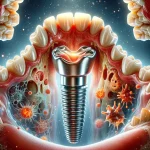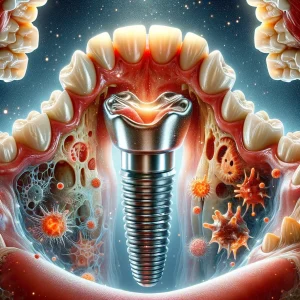What is Peri-implantitis?
Peri-implantitis is a pathological condition occurring around dental implants, characterized by inflammation in the surrounding gum tissue and a progressive loss of the supporting jawbone. It is considered the advanced stage of peri-implant disease, evolving from an earlier, reversible condition known as peri-implant mucositis, where inflammation is confined only to the soft tissues. The defining feature of peri-implantitis is the destruction of osseointegration—the crucial direct bond between the bone and the implant’s surface. As this bond breaks down, the implant loses its stable foundation in the jaw, which can ultimately lead to its failure.
Causes:- Bacterial Biofilm Accumulation: The process begins with the formation of a bacterial biofilm, commonly known as plaque, on the surfaces of the dental implant and its attached restoration (crown). This sticky film is a complex, organized community of microorganisms that adheres tenaciously to any part of the implant structure exposed in the mouth.
- Progression to Calculus: If this initial biofilm is not consistently removed, it absorbs minerals from saliva and hardens into a rough deposit called calculus (or tartar). This calcified layer provides an even more protective and textured surface for new bacteria to colonize, intensifying the microbial challenge to the surrounding tissues.
- Host Inflammatory Response: In response to the persistent bacterial presence, the body's immune system launches a powerful inflammatory cascade. While intended to fight the infection, this response inadvertently releases enzymes and other substances that break down the surrounding soft tissue and, critically, resorb the jawbone that is fused to the implant, leading to bone loss.
- Individuals with a History of Periodontitis: A patient who has previously lost natural teeth due to severe gum disease is highly susceptible. This history indicates a host immune system that is likely predisposed to mount an aggressive, tissue-damaging inflammatory response when challenged by bacterial plaque, a trait that carries over to the tissues surrounding an implant.
- Those with Inadequate Oral Hygiene: Inconsistent or ineffective cleaning practices are the most direct contributor. The failure to meticulously remove the daily accumulation of bacterial biofilm from all surfaces of the implant and its restoration allows the destructive disease process to initiate and advance.
- Cigarette Smokers: The use of tobacco is a powerful risk factor. Smoking impairs the blood supply to the gums, compromises the local immune response within the mouth, and can mask early warning signs like bleeding, allowing the disease to progress to a more severe state before being detected.
- Patients with Uncontrolled Systemic Diseases: Certain medical conditions, most notably poorly managed diabetes mellitus, elevate risk considerably. Chronically high blood sugar levels can weaken the body's overall ability to fight infection and can exaggerate the inflammatory response to bacteria, making the tissues around the implant more vulnerable to breakdown.

